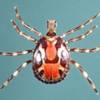Abstract
The tropical bont tick is considered one of the most detrimental of the tick species present in Africa and now the Caribbean. It can result in severe economic losses due to hide damage, milk production reduction, and death of livestock. This 7-page fact sheet was written by Karen C. Prine and Amanda C. Hodges, and published by the UF Department of Entomology and Nematology, June 2012.
References
Alderink FJ, McCauley EH. 1988. The probability of the spread of Amblyomma variegatum in the Caribbean. Preventive Veterinary Medicine 6: 265-294. https://doi.org/10.1016/0167-5877(88)90040-2
Allan SA, Barré N, Sonenshine DE, Burridge, MJ. 1998. Efficacy of tags impregnated with pheromone and acaricide for control of Amblyomma variegatum. Medical and Veterinary Entomology 12: 141-150. https://doi.org/10.1046/j.1365-2915.1998.00080.x
Barré N, Uilenberg G, Morel PC, Camus E. 1987. Danger of introducing heartwater onto the American mainland: potential role of indigenous and exotic Amblyomma ticks. Onderstepoort Journal of Veterinary Research 54: 405-417.
Barré N, Garris GL. 1990. Biology and ecology of Amblyomma variegatum (Acari: Ixodidae) in the Caribbean: implications for a regional eradication program. Journal of Agricultural Entomology 7: 1-9.
Barré N, Garris G, Camus E. 1995. Propagation of the tick Amblyomma variegatum in the Caribbean. Scientific and Technical Review of the Office International des Epizooties 14: 841-855. https://doi.org/10.20506/rst.14.3.883
(CaribVet). (January 2011a). Dermatophilosis. Caribbean Animal Health Network. http://www.caribvet.net/en/monograph-0 (20 February 2012).
(CaribVet). (January 2011b). Heartwater. Caribbean Animal Health Network. http://www.caribvet.net/en/monograph-1 (20 February 2012).
(CDC) Center for Disease Control and Prevention. (May 2001). Yellow fever surveillance-Africa. Morbidity and Mortality Weekly Report. http://www.cdc.gov/mmwr/preview/mmwrhtml/00001149.htm (15 February 2012).
(CFSPH) Center for Food Security and Public Health. (December 2006). Amblyomma variegatum. International Veterinary Information Service. http://www.ivis.org/advances/Disease_Factsheets/amblyomma_variegatum.pdf (20 Fedruary 2012).
Deem SL. 1998. A review of heartwater and the threat of introduction of Cowdria ruminantium and Amblyomma spp. ticks to the American mainland. Journal of Zoo and Wildlife Medicine 29: 109-133.
Georgi JR, Georgi ME. 1990. Arthropods: family Ixodidae, pp. 1-76. In Parasitology for Veterinarians, 5th edition. W. B. Saunders Co, Philadelphia, PA. pp 412.
Jongejan F. 1992. Experimental transmission of Cowdria ruminantium (Rickettsiales) by the American reptile tick Amblyomma dissimile Koch, 1844. Experimental and Applied Acarology 15: 117-121. https://doi.org/10.1007/BF01275522
Kelly P, H Lucas, L Beati, C Yowell, S Mahan, J Dame. 2010. Rickettsia africae in Amblyomma variegatum and domestic ruminants on eight Caribbean islands. Journal of Parasitology 96: 1086-1088. https://doi.org/10.1645/GE-2552.1
(Merck) (2011). Important Ixodid ticks: Amblyomma spp. The Merck Veterinary Manual. http://www.merckvetmanual.com/mvm/index.jsp?cfile=htm/bc/72107.htm (15 February 2012).
(NTHNC) National Travel Health and Network Centre. 2008. Travel Health Information Sheets: Rickettsial Diseases. http://www.nathnac.org/pro/factsheets/rick.htm (15 May 2012).
Ndumu PA, George BD, Choudhury MK. 1999. Toxicity of Neem seed oil (Azidiracta indica) against the larvae of Amblyomma variegatum, a three-host tick in cattle. Phytotherapy Research 13: 532-534. https://doi.org/10.1002/(SICI)1099-1573(199909)13:6<532::AID-PTR492>3.0.CO;2-C
Norval RAI, Peter T, Sonenshine DE, Burridge ME. 1992. Responses of the ticks Amblyomma hebraeum and A. variegatum to known or potential components of the aggregation-attachment pheromone. III. Aggregation. Experimental and Applied Acarology 16: 237-245. https://doi.org/10.1007/BF01193806
(OIE) (October 2009). Heartwater - Cowdriosis. World Organization for Animal Health. http://www.oie.int/fileadmin/Home/eng/Animal_Health_in_the_World/docs/pdf/HEARTWATER_FINAL.pdf (15 February 2012).
Parola P, Vestris G, Martinez D, Brochier B, Roux V, Raoult D. 1999. Tick-borne rickettiosis in Guadeloupe, the French West Indies: isolation of Rickettsia africae from Amblyomma variegatum ticks and serosurvery in humans, cattle, and goats. American Journal of Tropical Medicine and Hygiene 60: 888-893. https://doi.org/10.4269/ajtmh.1999.60.888
Pegram RG, Banda DS. 1990. Ecology and phenology of cattle ticks in Zambia: development and survival of free-living stages. Experimental and Applied Acarology 8: 291-301. https://doi.org/10.1007/BF01202139
Pegram RG, Eddy C. 2002. Progress towards the eradication of Amblyomma variegatum from the Caribbean. Experimental and Applied Acarology 28: 273-281 https://doi.org/10.1023/A:1025375206346
Pegram R, Indar L, Eddi C, George J. 2004. The Caribbean Amblyomma program: some ecologic factors affecting its success. Annals of the New York Academy of Sciences 1026: 302-311. https://doi.org/10.1196/annals.1307.056
Popham TE, Garris GI, Barré N. 1996. Development of a computer model of the population dynamics of Amblyomma variegatum and simulations of eradication strategies for use in the Caribbean. Annals of the New York Academy of Sciences 791: 452-465. https://doi.org/10.1111/j.1749-6632.1996.tb53554.x
Samish M. 2006. Biocontol of ticks. Annals of the New York Academy of Sciences 916: 172-178. DOI: 10.1111/j.1749-6632.2000.tb05287.x https://doi.org/10.1111/j.1749-6632.2000.tb05287.x
Stachurski F, Lancelot R. 2006. Footbath acaricide treatment to control cattle infestation by the tick Amblyomma variegatum. Medical and Veterinary Entomology 20: 402-412 https://doi.org/10.1111/j.1365-2915.2006.00648.x
Walker AR. 1996. Amblyomma tick feeding in relation to host health. Tropical Animal Health and Production 28: 26S-28S. https://doi.org/10.1007/BF02310695
Walker AR, Bouattour A, Camicas JL, Estrada-Peña A, Horak IG, Latif AA, Pegram KG, Preston PM. 2007. Ticks of Domestic Animals in Africa: A Guide to Identification of Species. Bioscience Reports. 221 pp.
Yonow T. 1995. The life-cycle of Amblyomma variegatum (Acari: Ixodidae): a literature synthesis with a view to modeling. International Journal for Parasitology 9: 1023-1060 https://doi.org/10.1016/0020-7519(95)00020-3

